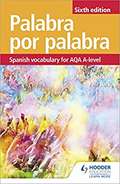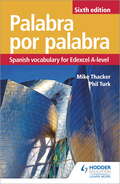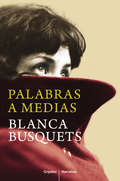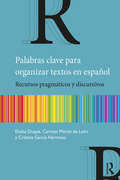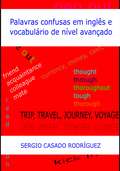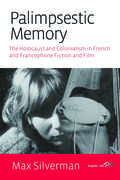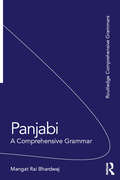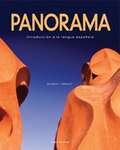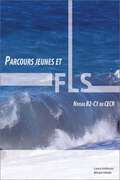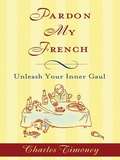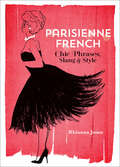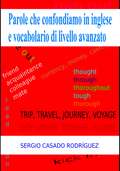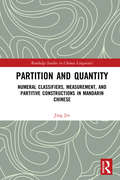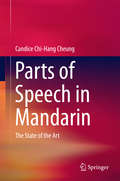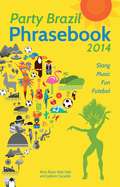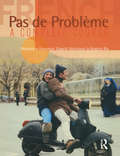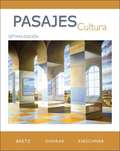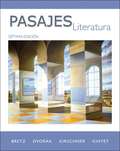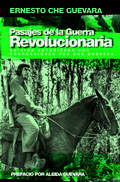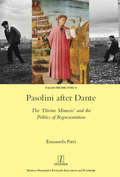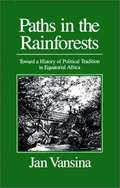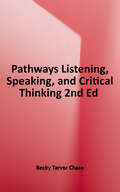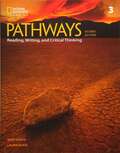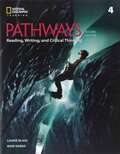- Table View
- List View
Palabra por Palabra Sixth Edition: Spanish Vocabulary for AQA A-level
by Phil Turk Mike ThackerExam board: AQALevel: A-levelSubject: SpanishFirst teaching: September 2016First exams: Summer 2018Essential vocabulary for AQA A-level Spanish, all in one place.- Supplement key resources such as course textbooks with all the vocab students need to know in one easy-to-navigate place, completed updated to match the latest specification - Ensure extensive vocab coverage with topic-by-topic lists of key words and phrases, including a new section dedicated to film and literature - Test students' knowledge with end-of-topic activities designed to deepen their understanding of word patterns and relationships - Develop effective strategies for learning new vocab and dealing with unfamiliar words
Palabra por Palabra Sixth Edition: Spanish Vocabulary for Edexcel A-level
by Phil Turk Mike ThackerExam board: EdexcelLevel: A-levelSubject: SpanishFirst teaching: September 2017First exams: Summer 2018Essential vocabulary for Edexcel A level Spanish, all in one place.- Supplement key resources such as course textbooks with all the vocab students need to know in one easy-to-navigate place, completed updated to match the latest specification - Ensure extensive vocab coverage with topic-by-topic lists of key words and phrases, including a new section dedicated to film and literature - Test students' knowledge with end-of-topic activities designed to deepen their understanding of word patterns and relationships - Develop effective strategies for learning new vocab and dealing with unfamiliar words
Palabras a medias
by Blanca Busquets¿Te imaginas que tu padre, en su lecho de muerte, te confiesa que la noche del 23-F mató a un hombre? Te sorprendería, ¿verdad? Pues eso es lo que les pasó a Annabel, Albert y Nina, los tres protagonistas de Palabas a medias, que el 23 de febrero de 1981 tenían unos veinte años.A través del relato de cada uno de ellos, descubriremos que nadie es lo que parece y que todos los hermanos, sin saberlo, están enredados en una misma trama relacionada con contrabando, perfumes y desengaños amorosos de consecuencias imprevisibles.Una novela en la que lo que menos importa es lo que aconteció en el Congreso de los diputados aquella tarde del mes de febrero... De hecho, ninguno de los miembros de esta familia se enteró demasiado.Blanca Busquets, una de les voces mas personales de la narrativa actual, nos sorprende una vez más, ahora con esta magnífica historia coral de una familia tan fuera de la normalidad como común. Con un argumento redondo y unos personajes intensos ypróximos nos acerca a los secretos de cada uno de los protagonistas convirtiéndonos en cómplices de sus vidas. Y es que... ¿quién no tiene secretos con sus padres y hermanos? ¿O acaso tu familia lo sabe todo de ti?
Palabras clave para organizar textos en español: Recursos pragmáticos y discursivos
by Eladio Duque Carmen Martín de León Cristina Garcia HermosoPalabras clave para organizar textos en español: recursos pragmáticos y discursivos está dirigido a estudiantes de español como lengua extranjera –de nivel B2/ C1 (MCER) o Intermediate High/ Advanced Low (ACTFL)– que deseen mejorar la coherencia de sus textos hablados y escritos. En este libro el lector encontrará explicaciones teóricas acompañadas de numerosas actividades en las que pondrá en práctica una gran variedad de estructuras, estrategias y herramientas útiles para conectar frases y párrafos de manera eficaz.Palabras clave para organizar textos en español se fundamenta en el uso de la lengua en contextos de comunicación real. El libro puede utilizarse de manera independiente o como material de clase, ya que, además de las actividades con las que el aprendiz puede autoevaluar su progreso, también incluye actividades abiertas y juegos para trabajar en grupo.
Palavras confusas em inglês e vocabulário de nível avançado
by Sergio RodríguezEste ebook foi projetado para os estudantes de inglês que desejam atingir um nível avançado. As diferenças entre palavras que são facilmente confundidas são explicadas e há uma lista de vocabulário e expressões com seus respectivos exemplos.
Palimpsestic Memory
by Max SilvermanThe interconnections between histories and memories of the Holocaust, colonialism and extreme violence in post-war French and Francophone fiction and film provide the central focus of this book. It proposes a new model of 'palimpsestic memory', which the author defines as the condensation of different spatio-temporal traces, to describe these interconnections and defines the poetics and the politics of this composite form. In doing so it is argued that a poetics dependent on tropes and techniques, such as metaphor, allegory and montage, establishes connections across space and time which oblige us to perceive cultural memory not in terms of its singular attachment to a particular event or bound to specific ethno-cultural or national communities but as a dynamic process of transfer between different moments of racialized violence and between different cultural communities. The structure of the book allows for both the theoretical elaboration of this paradigm for cultural memory and individual case-studies of novels and films.
Panjabi: A Comprehensive Grammar (Routledge Comprehensive Grammars)
by Mangat BhardwajPanjabi: A Comprehensive Grammar is a complete reference guide to Panjabi grammar. It presents a fresh, accessible and thorough description of the language, concentrating on the real patterns of use in modern Panjabi. The book moves from the script and sound through morphology and word classes to a detailed analysis of sentence structures and semantic features. The volume is organized to promote a thorough understanding of Panjabi grammar. It offers a stimulating analysis of the complexities of the language, and provides full and clear explanations. Throughout, the emphasis is on Panjabi as used by present-day native speakers. An extensive index and numbered paragraphs provide readers with easy access to the information they require. Features include: detailed treatment of the common grammatical structures and parts of speech extensive exemplification particular attention to areas of confusion and difficulty Gurmukhi script and transliteration provided throughout additional chapter on the Shahmuki script Panjabi: A Comprehensive Grammar is an essential reference source for the learner and user of Panjabi. With clear and simple explanations it will remain the standard reference work for years to come for both learners and linguists alike. A Workbook and Reader to accompany this grammar can be downloaded from https://www.routledge.com/products/9781138793866. *Please note that, due to unforseen circumstances, the Workbook and Reader have been delayed.*
Panorama: Introducción a la lengua española
by José A. Blanco Philip Redwine DonleyPanorama, 4th Edition is an introductory Spanish program offering 15 contemporary, thematic lessons to introduce students to an extensive view of the Spanish-speaking world. Its fresh, student-friendly approach, effective integration of video, and powerful online tools lead students to effective personalized communication.
Parcours jeunes et FLS: Activités pédagogiques en français langue seconde, niveau B2 – C1 du CECR
by Laura Ambrosio Miriam HatabiConçu pour de jeunes adultes de niveau universitaire, Parcours jeunes et FLS est le fruit d’un regard jeune au service de l’enseignement et de l’apprentissage du français langue seconde de niveau intermédiaire et avancé (B2-C1). Ce manuel de format 8,5 x 11, à reliure boudinée et avec une mise en page aérée et colorée, propose une série de documents audio et vidéo structurés en neuf unités aux thématiques actuelles et est conçu pour optimiser l’expérience en salle de classe. Il appuie la conceptualisation et la réalisation d’activités pédagogiques qui reflètent les approches actuelles en enseignement des langues, tout en proposant des pistes d’apprentissage fidèles aux orientations du Cadre européen commun de référence pour les langues (CECRL). Il appuie aussi des compétences spécifiques et des approches plurielles favorables à l’épanouissement des apprenants, grâce au développement du savoir, du savoir-être et du savoir-faire du CARAP. Comme l’apprentissage des habiletés réceptives d’une langue seconde est influencé par l’authenticité, l’intérêt, la pertinence, et l’adaptabilité de documents choisis, Parcours jeunes et FLS propose un portrait actuel des mondes culturel, social, intellectuel, économique et professionnel des jeunes d’aujourd’hui. Les apprenants du FLS pourront se voir, se reconnaître et se représenter dans l’espace public extérieur à la salle de classe, renforçant ainsi leurs compétences métalinguistiques. Cet ouvrage est un exemple de la vitalité, de la vigueur et de la richesse des communautés francophones en situation minoritaire. Comprend un CD d’accompagnement de vidéos réalisées par des étudiants en journalisme de La Cité collégiale. Publié en français
Pardon My French
by Charles TimoneyTHINGS YOU DIDN'T KNOW ABOUT FRANCE : How to say Oh la la Smuggling live chickens into rugby matches is patriotic How many times to kiss on the cheek A six-pack is a bar of chocolate The dangers of being called Peter or Penny Ordering a steak without getting sneered at The importance of Wednesdays How to tip When to celebrate Christmas From sugar-cube etiquette to why the Marseillaise is all about slaughtering Austrians and Prussians as bloodily as possible, Charles Timoney lays bare the Gallic mindset alongside their bizarre language. Covering all areas of everyday life from eating and drinking to travel, work and, crucially, swearing and sounding like a teenager, this is not just the most entertaining, but also the most useful book on France and the French you'll ever read.
Parisienne French: Chic Phrases, Slang and Style
by Rhianna JonesTHE LANGUAGE OF LOVE FOR THE GIRL WITH JE NE SAIS QUOIYou've dreamed of Paris your whole life. You've imagined yourself sipping a café au lait at an outdoor bistro in the Jardin de Tuileries, or browsing a fashionable boutique on the Champs-Elysées, or strolling along the banks of the Seine, hand in hand with your handsome French lover. Now is the time to realize that dream.Parisienne French will have you cultured, chic and, most importantly, casually chatting with locals as if you were raised in the City of Lights. With refined phrases to express yourself at the Musée d'Orsay, posh vocabulary for catching up on this season's couture fashion and hip slang for flirting at the hottest nightclub, you'll effortlessly navigate the social scenes of Paris. Your new eloquent French will win over any vrai patriote, who will warmly welcome you to la vie parisienne.
Parole che confondiamo in inglese e vocabolario di livello avanzato
by Sergio Casado RodríguezÈ un libro che aiuta a dissipare i dubbi che si hanno nell'imparare l'inglese per i non nativi. Il libro si divide per concetti e sppiega, con tanto di esempi, l'uso ed il coretto significato delle parole prese in analisi.
Partition and Quantity: Numeral Classifiers, Measurement, and Partitive Constructions in Mandarin Chinese (Routledge Studies in Chinese Linguistics)
by Jing JinPartition and Quantity: Numeral Classifiers, Measurement, and Partitive Constructions in Mandarin Chinese presents an in-depth investigation into the semantic and syntactic properties of Chinese classifiers and conducts a comprehensive examination on the use of different quantity constructions in Chinese. This book echoes a rapid development in the past decades in Chinese linguistics research within the generative framework on Chinese classifier phrases, an area that has emerged as one of the most cutting-edge themes in the field of Chinese linguistics. The book on the one hand offers a closer scrutiny on empirical data and revisits some long-lasting research problems, such as the semantic factor bearing on the formation of Chinese numeral classifier constructions, the (non-)licensing of the linker de (的) in between the numeral classifier and the noun, and the conditions regulating the use of pre-classifier adjectives. On the other hand, particular attention is paid to the issues that have been less studied or gone unnoticed in previous studies, including a (more) fine-grained subcategorization of Chinese measurement constructions, the multiple grammatical roles played by the marker de (的) in different numeral classifier constructions, the formation and derivation of Chinese partitive constructions, etc.
Parts of Speech in Mandarin
by Candice Chi-Hang CheungThis book offers a comprehensive survey of the major parts of speech in Mandarin. Seeking to identify the sets of universal and language-specific categories, it compares the range of categories available in Mandarin and the Indo-European languages and establishes six universal categories - nouns, verbs, adjectives, adverbs, prepositions and conjunctions - and three language-specific ones, namely classifiers, localizers and sentence-final particles. Incorporating insights from recent research findings and the diachronic development of the language, the book sheds new light on the factors that contribute to the long-standing debate on the categorical status of adjectives, prepositions and localizers in the extant literature. Bringing together the earlier general descriptions and the latest advances, it is broadly accessible to non-native and native speakers of the language and offers an ideal reference source for all students and scholars who are interested in studying the parts of speech in Mandarin.
Party Brazil Phrasebook 2014: Slang, Music, Fun and Futebol
by Alice Rose Nati Vale Jadson CaçadorYOUR TICKET TO THE WORLD'S BIGGEST PARTYWith this book in hand you can get off the sideline and join the local Brazilians as they party during World Cup 2014. Chock-full of up-to-date slang phrases, after-hours expressions and insider information on futebol, this book will have you cheering, dancing, drinking and celebrating with the die-hard fans of the beautiful game. You're sure to have the most memorable World Cup ever as you toss out phrases like:What's up, man? Iaí, cara? Can I join your pickup game? Posso bater uma pelada com vocês? Where is a cool bar to watch the game? Onde tem um barzinho legal pra assitir o jogo? Next round's on me. A proxima rodada é minha. We're all going to an underground dance club, wanna join? A gente vai pra um baile funk, tá afim? That girl in the VIP section is super hot. Aquela mina no camarote é muito gostosa. Let's sleep off our hangovers at the beach. Vamos curar a ressaca na praia.
Pas de Probleme: Student Book
by Madeleine Hummler Brigitte Rix Elspeth NicholsPas de problème is a highly illustrative and communicative course designed for adults of all ages, from those with a 'rusty' recollection of school French to those advancing in the acquisition of a new language on a fast track. It will give students a thorough grounding in all the skills required to understand, speak, read and write contemporary French.The coursebook consists of 12 lively, illustrated chapters covering different broad themes and providing plenty of diverse material from technical to light-hearted. A wide range of registers is covered, from everyday idioms to formal letter-writing phrases. Each chapter contains the following: * sections reminding students of essential vocabulary and structures* explanations of new grammar in one single block for easy reference* reading and listening exercises* new vocabulary lists to aid self-study* role-playing exercises * internet addresses for further research* boxes containing helpful learning tips Audio files to accompany this book are available free of charge at www.routledge.com/cw/hummler
Pasajes Cultura
by Mary Lee Bretz Trisha Dvorak Carl KirschnerThe Pasajes series is one of the most widely used and highly respected programs for intermediate Spanish courses in North America. As in previous editions, the seventh edition of Pasajes consists of three volumes, all coordinated by theme, chapter by chapter: a review of grammar (Lengua), a cultural reader Cultura), and a literary reader (Literatura). The result is a very flexible program that can be used in any combination and thus is easily adapted to suit the needs of a wide variety of instructors and intermediate courses. The new edition offers a new film feature in Lengua with pre- and post-viewing questions and an accompanying image. In addiiton, Literatura and Cultura each have three new or revised readings. All three volumes have a modified interior design, as well as updated and revised activities and photos.
Pasajes Literatura
by Mary Lee Bretz Trisha Dvorak Carl Kirschner Constance KihyetThe Pasajes series is one of the most widely used and highly respected programs for intermediate Spanish courses in North America. As in previous editions, the seventh edition of Pasajes consists of three volumes, all coordinated by theme, chapter by chapter: a review of grammar (Lengua), a cultural reader Cultura), and a literary reader (Literatura). The result is a very flexible program that can be used in any combination and thus is easily adapted to suit the needs of a wide variety of instructors and intermediate courses. The new edition offers a new film feature in Lengua with pre- and post-viewing questions and an accompanying image. In addiiton, Literatura and Cultura each have three new or revised readings. All three volumes have a modified interior design, as well as updated and revised activities and photos.
Pasajes de la guerra revolucionaria
by Ernesto Che Guevara Aleida GuevaraChe Guevara's classic account of the 1956-58 guerrilla movement against the Batista dictatorship in Cuba. Here, the dramatic art and acute perceptiveness evident in Che Guevara's early diaries fully blossom in this highly readable and often entertaining account of the guerrilla war that led to the 1959 Cuban Revolution. One of two books on which Steven Soderbergh and Benicio Del Toro have based their new Che movie.
Pasolini after Dante: The 'Divine Mimesis' and the Politics of Representation (Legenda)
by Emanuela PattiWhat role did Dante play in the work of Pier Paolo Pasolini (1922-1975)? His unfinished and fragmented imitation of the Comedia, La Divina Mimesis, is only one outward sign of what was a sustained dialogue with Dante on representation begun in the early 1950s. During this period, the philologists Gianfranco Contini (1912-1990) and Erich Auerbach (1892-1957) played a crucial role in Pasolini’s re-thinking of ‘represented reality’, suggesting Dante as the best literary, authorial and political model for a generation of postwar Italian writers. This emerged first as ‘Dantean realism’ in Pasolini’s prose and poetry, after Contini’s interpretation of Dante and of his plurilingualism, and then as ‘figural realism’ in his cinema, after Auerbach’s concepts of Dante’s figura and ‘mingling of styles’. Following the evolution of Pasolini’s mimetic ideal from these formative influences through to La Divina Mimesis, Emanuela Patti explores Pasolini’s politics of representation in relation to the ‘national-popular’, the ‘questione della lingua’ and the Italian post-war debates on neorealism, while also providing a new interpretation of some of his major literary and cinematic works.
Paths in the Rainforests: Toward a History of Political Tradition in Equatorial Africa
by Jan VansinaVansina's scope is breathtaking: he reconstructs the history of the forest lands that cover all or part of southern Cameroon, Gabon, Equatorial Guinea, the Congo, Zaire, discussing the original settlement of the forest by the western Bantu.
Pathways: Listening, Speaking, and Critical Thinking 1
by Becky Tarver ChasePathways, Second Edition, is a global, five-level academic English program. Carefully-guided lessons develop the language skills, critical thinking, and learning strategies required for academic success. Using authentic and relevant content from National Geographic, including video, charts, and other infographics, Pathways prepares students to work effectively and confidently in an academic environment.
Pathways: Reading, Writing, And Critical Thinking 3
by Mari Vargo Laurie BlassPathways, Second Edition, is a global, five-level academic English program. Carefully-guided lessons develop the language skills, critical thinking, and learning strategies required for academic success. Using authentic and relevant content from National Geographic, including video, charts, and other infographics, Pathways prepares students to work effectively and confidently in an academic environment.
Pathways: Reading, Writing, and Critical Thinking 4
by Mari Vargo Laurie BlassPathways, Second Edition, is a global, five-level academic English program. Carefully-guided lessons develop the language skills, critical thinking, and learning strategies required for academic success. Using authentic and relevant content from National Geographic, including video, charts, and other infographics, Pathways prepares students to work effectively and confidently in an academic environment.
Patrones Crecientes (Growing Patterns): Los números de Fibonacci en la naturaleza
by Sarah C. CampbellAn ALSC Notable Children's BookA wondrous introduction to one of the most beautiful connections between mathematics and the natural world—the Fibonacci sequence—through a series of stunning nature photographs.Discover the biggest mathematical mystery in nature—Fibonacci numbers! Named after a famous mathematician, the number pattern is simple and starts with: 1, 1, 2, 3, 5, 8, 13. Each number in the sequence comes from adding the two numbers before it. What's the mystery? The pattern crops up in the most unexpected places. You'll find it in the disk of a sunflower, the skin of a pineapple, and the spiral of a nautilus shell. This book brings math to life, celebrates science, and inspires kids to see nature through new eyes.
